Impact of Governance and Stewardship Theories on Organizations
VerifiedAdded on 2023/06/04
|14
|3799
|251
Essay
AI Summary
This essay provides an in-depth analysis of governance and stewardship theories and their contribution to organizational effectiveness. It delves into key theories such as agency theory, stewardship theory, resource dependency theory, stakeholder theory, transaction cost theory, and political theory, highlighting their impact on organizational operations. The essay further discusses the contributions of stewardship theory in both non-profit and for-profit organizations, emphasizing the role of a steward in protecting stakeholder interests. It also explores the relationship between a leader's values and beliefs and their influence on effective governance, highlighting the importance of sustainability, quality, and ethical considerations. The essay concludes by underscoring the significance of adapting governance strategies to meet evolving organizational needs and complexities.
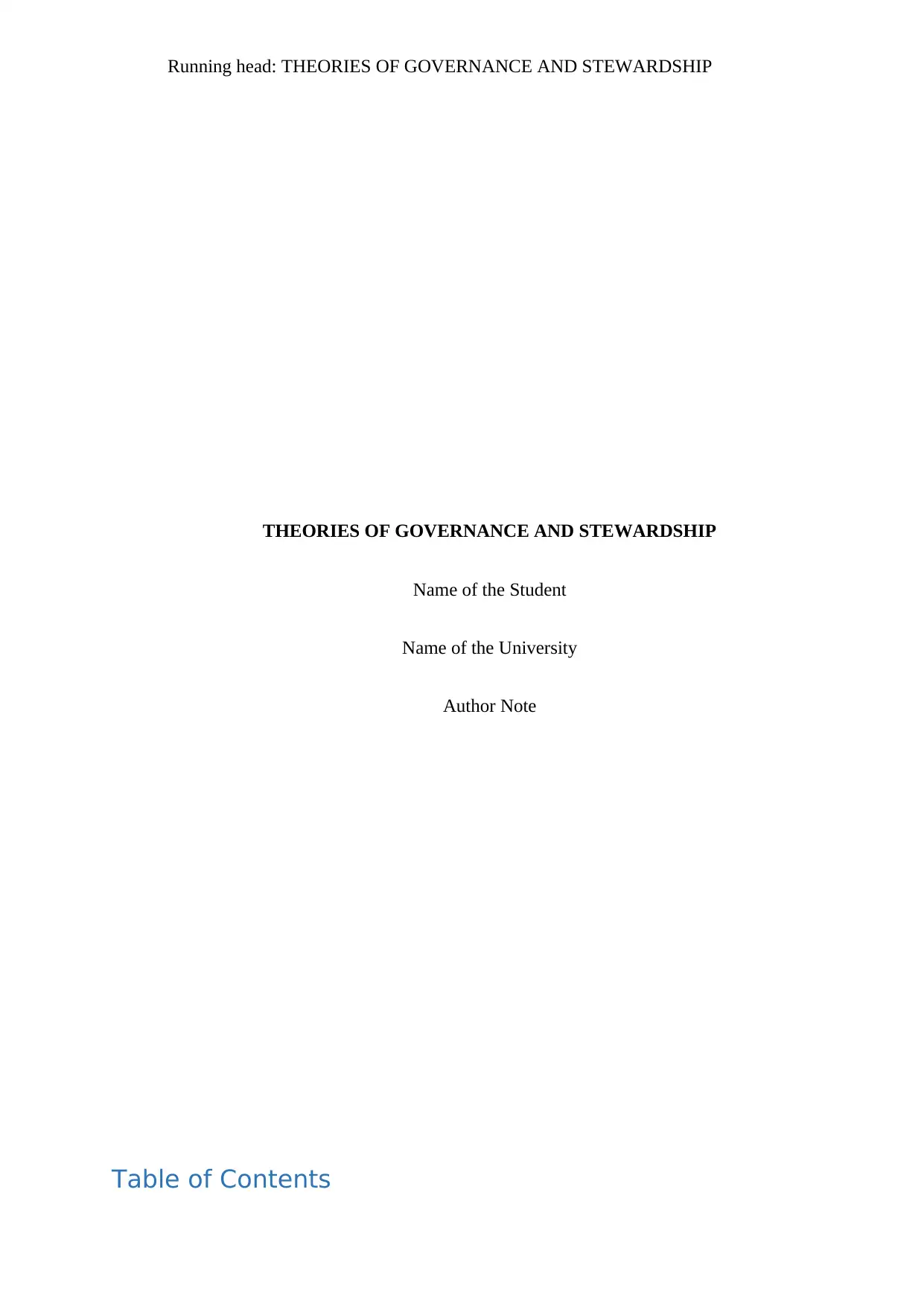
Running head: THEORIES OF GOVERNANCE AND STEWARDSHIP
THEORIES OF GOVERNANCE AND STEWARDSHIP
Name of the Student
Name of the University
Author Note
Table of Contents
THEORIES OF GOVERNANCE AND STEWARDSHIP
Name of the Student
Name of the University
Author Note
Table of Contents
Paraphrase This Document
Need a fresh take? Get an instant paraphrase of this document with our AI Paraphraser
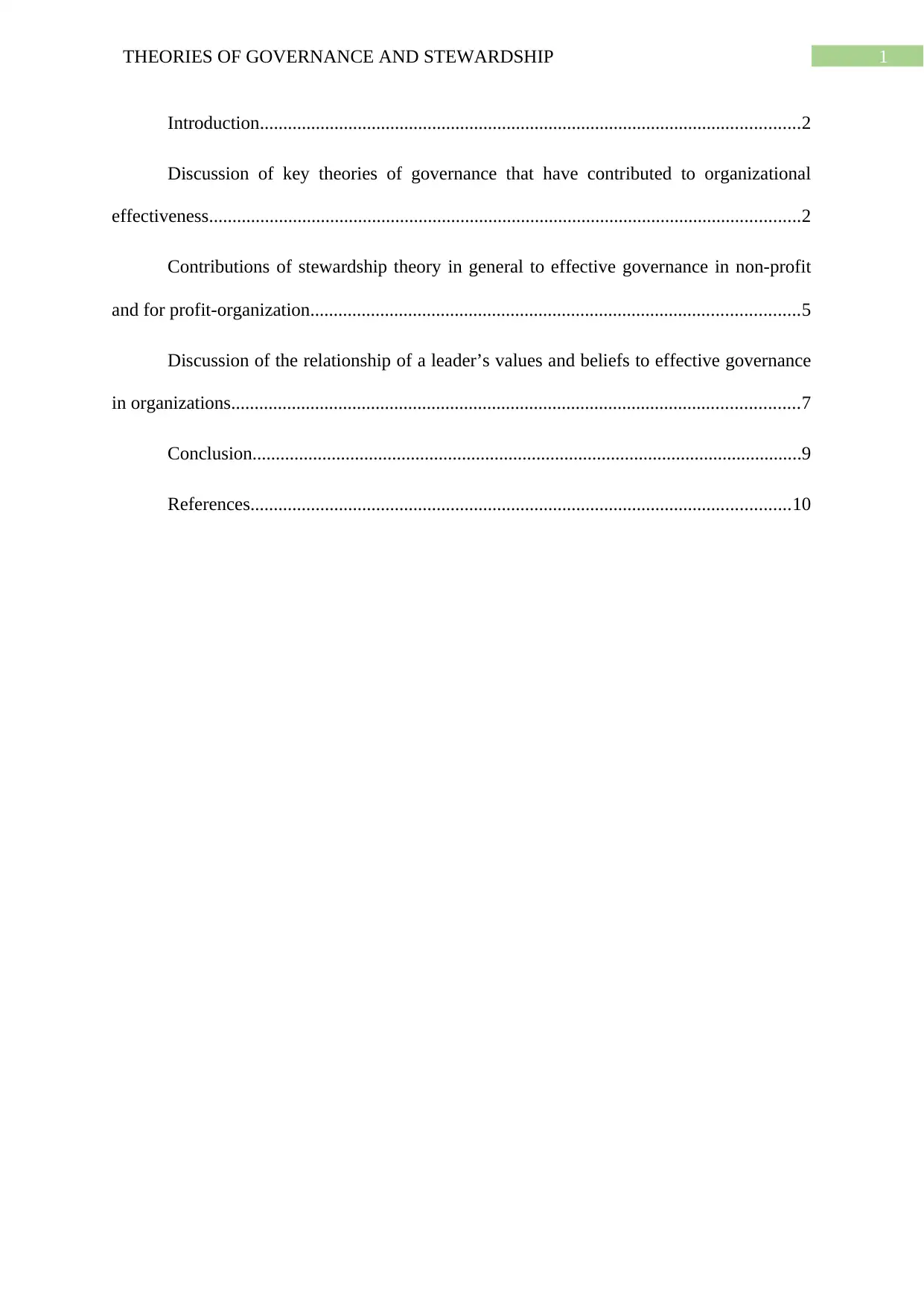
1THEORIES OF GOVERNANCE AND STEWARDSHIP
Introduction....................................................................................................................2
Discussion of key theories of governance that have contributed to organizational
effectiveness...............................................................................................................................2
Contributions of stewardship theory in general to effective governance in non-profit
and for profit-organization.........................................................................................................5
Discussion of the relationship of a leader’s values and beliefs to effective governance
in organizations..........................................................................................................................7
Conclusion......................................................................................................................9
References....................................................................................................................10
Introduction....................................................................................................................2
Discussion of key theories of governance that have contributed to organizational
effectiveness...............................................................................................................................2
Contributions of stewardship theory in general to effective governance in non-profit
and for profit-organization.........................................................................................................5
Discussion of the relationship of a leader’s values and beliefs to effective governance
in organizations..........................................................................................................................7
Conclusion......................................................................................................................9
References....................................................................................................................10
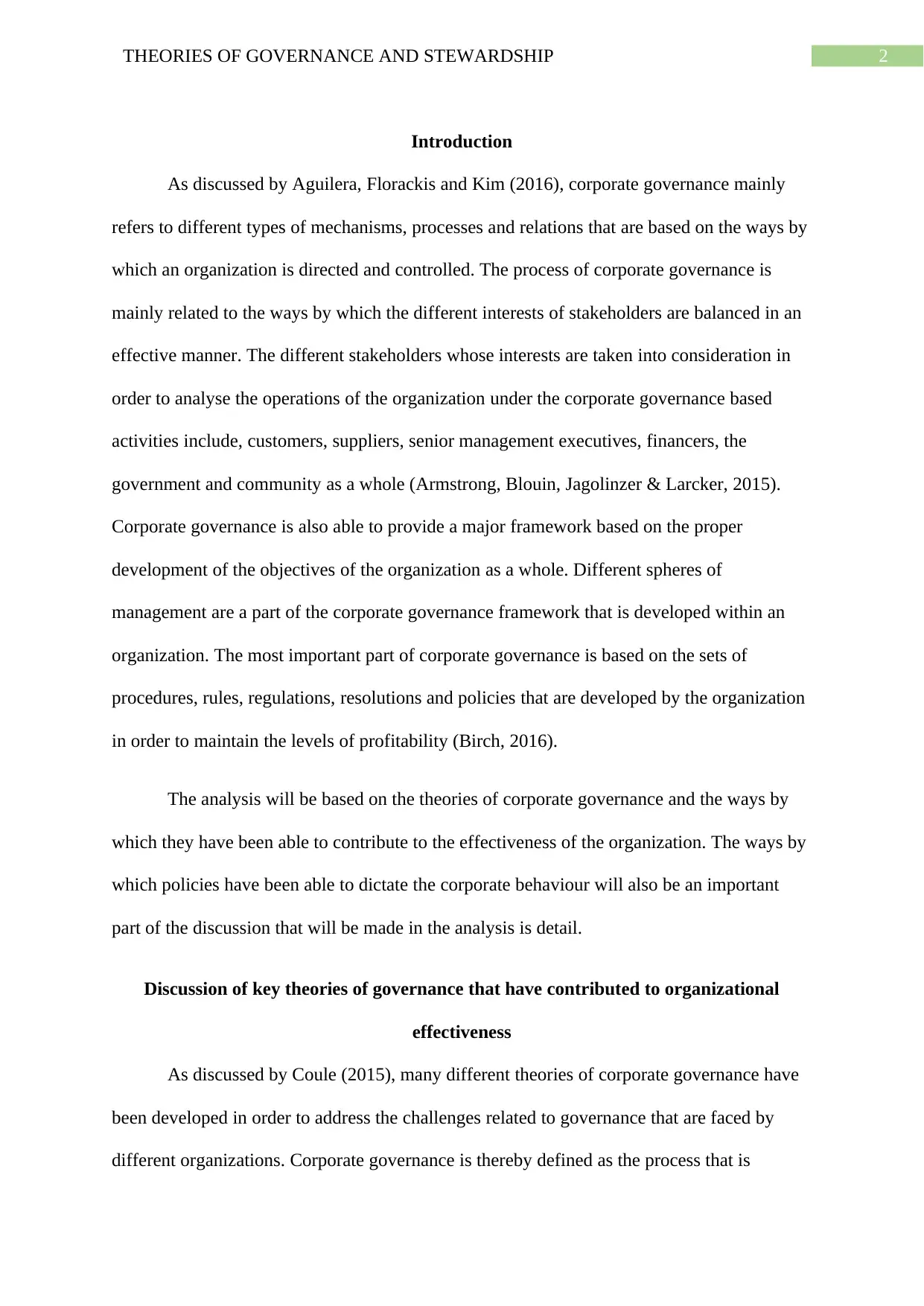
2THEORIES OF GOVERNANCE AND STEWARDSHIP
Introduction
As discussed by Aguilera, Florackis and Kim (2016), corporate governance mainly
refers to different types of mechanisms, processes and relations that are based on the ways by
which an organization is directed and controlled. The process of corporate governance is
mainly related to the ways by which the different interests of stakeholders are balanced in an
effective manner. The different stakeholders whose interests are taken into consideration in
order to analyse the operations of the organization under the corporate governance based
activities include, customers, suppliers, senior management executives, financers, the
government and community as a whole (Armstrong, Blouin, Jagolinzer & Larcker, 2015).
Corporate governance is also able to provide a major framework based on the proper
development of the objectives of the organization as a whole. Different spheres of
management are a part of the corporate governance framework that is developed within an
organization. The most important part of corporate governance is based on the sets of
procedures, rules, regulations, resolutions and policies that are developed by the organization
in order to maintain the levels of profitability (Birch, 2016).
The analysis will be based on the theories of corporate governance and the ways by
which they have been able to contribute to the effectiveness of the organization. The ways by
which policies have been able to dictate the corporate behaviour will also be an important
part of the discussion that will be made in the analysis is detail.
Discussion of key theories of governance that have contributed to organizational
effectiveness
As discussed by Coule (2015), many different theories of corporate governance have
been developed in order to address the challenges related to governance that are faced by
different organizations. Corporate governance is thereby defined as the process that is
Introduction
As discussed by Aguilera, Florackis and Kim (2016), corporate governance mainly
refers to different types of mechanisms, processes and relations that are based on the ways by
which an organization is directed and controlled. The process of corporate governance is
mainly related to the ways by which the different interests of stakeholders are balanced in an
effective manner. The different stakeholders whose interests are taken into consideration in
order to analyse the operations of the organization under the corporate governance based
activities include, customers, suppliers, senior management executives, financers, the
government and community as a whole (Armstrong, Blouin, Jagolinzer & Larcker, 2015).
Corporate governance is also able to provide a major framework based on the proper
development of the objectives of the organization as a whole. Different spheres of
management are a part of the corporate governance framework that is developed within an
organization. The most important part of corporate governance is based on the sets of
procedures, rules, regulations, resolutions and policies that are developed by the organization
in order to maintain the levels of profitability (Birch, 2016).
The analysis will be based on the theories of corporate governance and the ways by
which they have been able to contribute to the effectiveness of the organization. The ways by
which policies have been able to dictate the corporate behaviour will also be an important
part of the discussion that will be made in the analysis is detail.
Discussion of key theories of governance that have contributed to organizational
effectiveness
As discussed by Coule (2015), many different theories of corporate governance have
been developed in order to address the challenges related to governance that are faced by
different organizations. Corporate governance is thereby defined as the process that is
⊘ This is a preview!⊘
Do you want full access?
Subscribe today to unlock all pages.

Trusted by 1+ million students worldwide

3THEORIES OF GOVERNANCE AND STEWARDSHIP
implemented in the large organizations in order to develop the decision making process in an
effective manner (Cuomo, Mallin & Zattoni, 2016). The relationship that has been developed
between different stakeholders is described with the help of corporate governance based
theories. The activities that are performed by the organization in this case are totally based on
the theories that are a part of corporate governance related theories that are formed and
implemented (Dignam & Galanis, 2016). The different theories of corporate governance that
are able to support the organizational operations are as follows,
Agency theory – The relationship that has been developed between the agents
and principals of an organization is defined with the help of agency theory.
According to the agency theory, principals of a company mainly hire agents in
order to perform specific tasks (Formentini & Taticchi, 2016). The major
expectations of the shareholders are based on the ways by which the agents are
able to the act and also make decisions that are helpful for the organizational
operations. The agent is able to make decisions that are mainly related to the
expectations of stakeholders instead of the levels of self-interest (Elmagrhi et
al., 2017).
Stewardship theory – The steward theory mainly states that the steward is able
protect and maximise the wealth of the organization with the help of
performance. The stewards mainly include, the managers and company
executives who mainly work for shareholders and are able to gain profit for
them as well (Garcia-Torea, Fernandez-Feijoo & de la Cuesta, 2016).
Stewards are thereby motivated and satisfied with the help of levels of success
that is gained by the organization. The position of executives or employees is
taken into consideration in order to act in a more autonomous manner.
implemented in the large organizations in order to develop the decision making process in an
effective manner (Cuomo, Mallin & Zattoni, 2016). The relationship that has been developed
between different stakeholders is described with the help of corporate governance based
theories. The activities that are performed by the organization in this case are totally based on
the theories that are a part of corporate governance related theories that are formed and
implemented (Dignam & Galanis, 2016). The different theories of corporate governance that
are able to support the organizational operations are as follows,
Agency theory – The relationship that has been developed between the agents
and principals of an organization is defined with the help of agency theory.
According to the agency theory, principals of a company mainly hire agents in
order to perform specific tasks (Formentini & Taticchi, 2016). The major
expectations of the shareholders are based on the ways by which the agents are
able to the act and also make decisions that are helpful for the organizational
operations. The agent is able to make decisions that are mainly related to the
expectations of stakeholders instead of the levels of self-interest (Elmagrhi et
al., 2017).
Stewardship theory – The steward theory mainly states that the steward is able
protect and maximise the wealth of the organization with the help of
performance. The stewards mainly include, the managers and company
executives who mainly work for shareholders and are able to gain profit for
them as well (Garcia-Torea, Fernandez-Feijoo & de la Cuesta, 2016).
Stewards are thereby motivated and satisfied with the help of levels of success
that is gained by the organization. The position of executives or employees is
taken into consideration in order to act in a more autonomous manner.
Paraphrase This Document
Need a fresh take? Get an instant paraphrase of this document with our AI Paraphraser

4THEORIES OF GOVERNANCE AND STEWARDSHIP
Employees can thereby take ownership of the jobs that are performed by them
(Glinkowska & Kaczmarek, 2015).
Resource dependency theory – The Resource Dependency theory mainly
focusses on role that is played by the directors of an organization so that
access can be provided to the resources of the organization. The process that is
implemented in order to secure the resources required by the organization is
related to the link that is developed with external environment (Griffith, 2015).
The major provision of the process of resource enhancement is based on the
enhancement of the functions of the organization. The directors have the
ability to bring the resources to an organization that include, skills, resources,
buyers, public policy based makers, social groups and many more. The
Directors on the other hand can be classified into different categories that
include, business experts, community influencers, support specialists
(Hussain, Rigoni & Orij, 2018).
Stakeholder theory – The stakeholder theory mainly incorporates levels of
accountability that the management has towards the stakeholders of the
organization. The managers of the organizations have been able to develop a
network based on the relationships between employees, business partners and
suppliers. The major focus of the theory is based on the process of managerial
decision making and the interests of the stakeholders that are able to dominate
other employees or entities within the organization (Levermore & Moore,
2015).
Transaction cost theory – The transaction cost theory is based on the ways by
which different contracts have been gained by the organization and the value
that is developed as a whole. The cost that is mainly associated with different
Employees can thereby take ownership of the jobs that are performed by them
(Glinkowska & Kaczmarek, 2015).
Resource dependency theory – The Resource Dependency theory mainly
focusses on role that is played by the directors of an organization so that
access can be provided to the resources of the organization. The process that is
implemented in order to secure the resources required by the organization is
related to the link that is developed with external environment (Griffith, 2015).
The major provision of the process of resource enhancement is based on the
enhancement of the functions of the organization. The directors have the
ability to bring the resources to an organization that include, skills, resources,
buyers, public policy based makers, social groups and many more. The
Directors on the other hand can be classified into different categories that
include, business experts, community influencers, support specialists
(Hussain, Rigoni & Orij, 2018).
Stakeholder theory – The stakeholder theory mainly incorporates levels of
accountability that the management has towards the stakeholders of the
organization. The managers of the organizations have been able to develop a
network based on the relationships between employees, business partners and
suppliers. The major focus of the theory is based on the process of managerial
decision making and the interests of the stakeholders that are able to dominate
other employees or entities within the organization (Levermore & Moore,
2015).
Transaction cost theory – The transaction cost theory is based on the ways by
which different contracts have been gained by the organization and the value
that is developed as a whole. The cost that is mainly associated with different
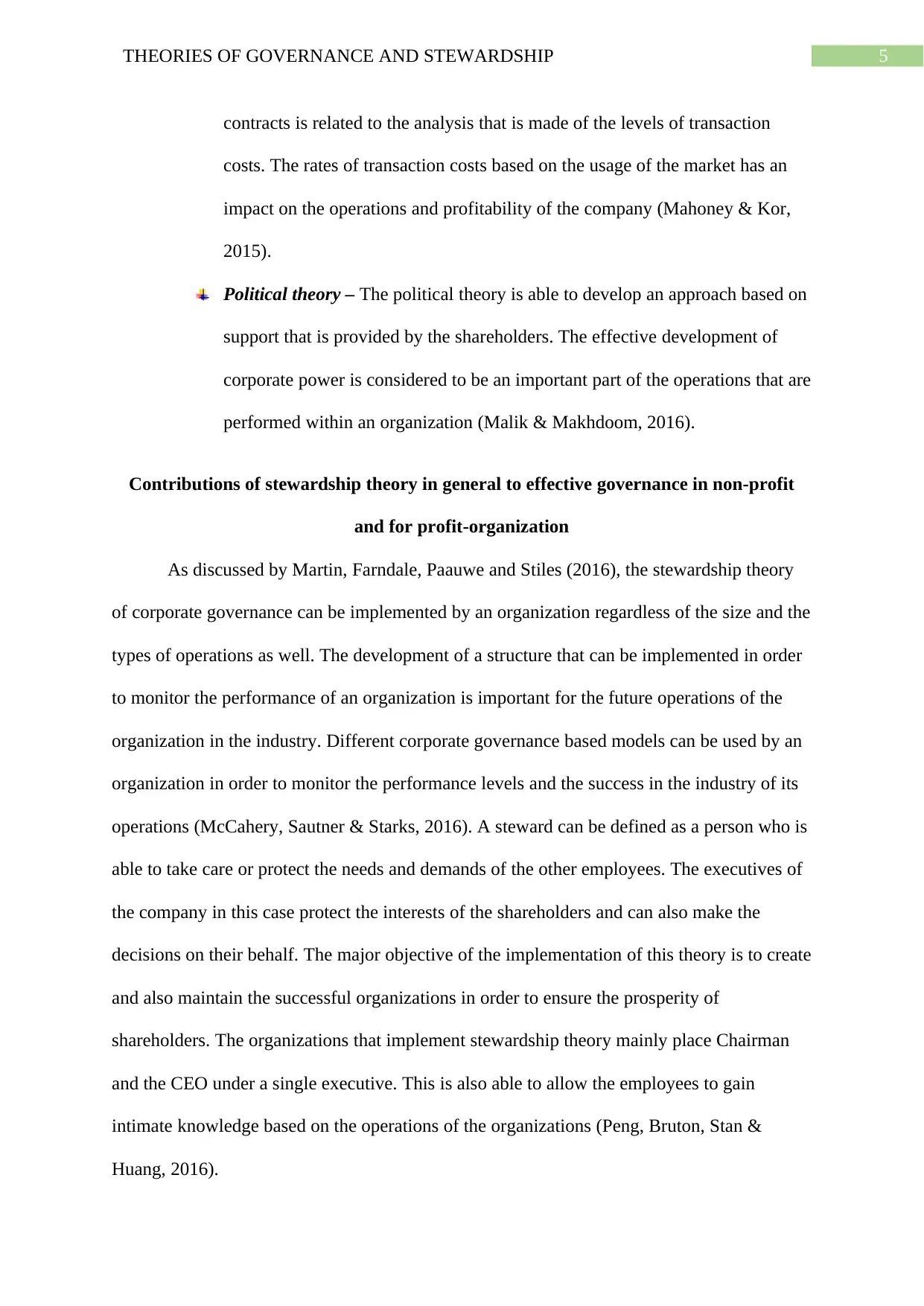
5THEORIES OF GOVERNANCE AND STEWARDSHIP
contracts is related to the analysis that is made of the levels of transaction
costs. The rates of transaction costs based on the usage of the market has an
impact on the operations and profitability of the company (Mahoney & Kor,
2015).
Political theory – The political theory is able to develop an approach based on
support that is provided by the shareholders. The effective development of
corporate power is considered to be an important part of the operations that are
performed within an organization (Malik & Makhdoom, 2016).
Contributions of stewardship theory in general to effective governance in non-profit
and for profit-organization
As discussed by Martin, Farndale, Paauwe and Stiles (2016), the stewardship theory
of corporate governance can be implemented by an organization regardless of the size and the
types of operations as well. The development of a structure that can be implemented in order
to monitor the performance of an organization is important for the future operations of the
organization in the industry. Different corporate governance based models can be used by an
organization in order to monitor the performance levels and the success in the industry of its
operations (McCahery, Sautner & Starks, 2016). A steward can be defined as a person who is
able to take care or protect the needs and demands of the other employees. The executives of
the company in this case protect the interests of the shareholders and can also make the
decisions on their behalf. The major objective of the implementation of this theory is to create
and also maintain the successful organizations in order to ensure the prosperity of
shareholders. The organizations that implement stewardship theory mainly place Chairman
and the CEO under a single executive. This is also able to allow the employees to gain
intimate knowledge based on the operations of the organizations (Peng, Bruton, Stan &
Huang, 2016).
contracts is related to the analysis that is made of the levels of transaction
costs. The rates of transaction costs based on the usage of the market has an
impact on the operations and profitability of the company (Mahoney & Kor,
2015).
Political theory – The political theory is able to develop an approach based on
support that is provided by the shareholders. The effective development of
corporate power is considered to be an important part of the operations that are
performed within an organization (Malik & Makhdoom, 2016).
Contributions of stewardship theory in general to effective governance in non-profit
and for profit-organization
As discussed by Martin, Farndale, Paauwe and Stiles (2016), the stewardship theory
of corporate governance can be implemented by an organization regardless of the size and the
types of operations as well. The development of a structure that can be implemented in order
to monitor the performance of an organization is important for the future operations of the
organization in the industry. Different corporate governance based models can be used by an
organization in order to monitor the performance levels and the success in the industry of its
operations (McCahery, Sautner & Starks, 2016). A steward can be defined as a person who is
able to take care or protect the needs and demands of the other employees. The executives of
the company in this case protect the interests of the shareholders and can also make the
decisions on their behalf. The major objective of the implementation of this theory is to create
and also maintain the successful organizations in order to ensure the prosperity of
shareholders. The organizations that implement stewardship theory mainly place Chairman
and the CEO under a single executive. This is also able to allow the employees to gain
intimate knowledge based on the operations of the organizations (Peng, Bruton, Stan &
Huang, 2016).
⊘ This is a preview!⊘
Do you want full access?
Subscribe today to unlock all pages.

Trusted by 1+ million students worldwide
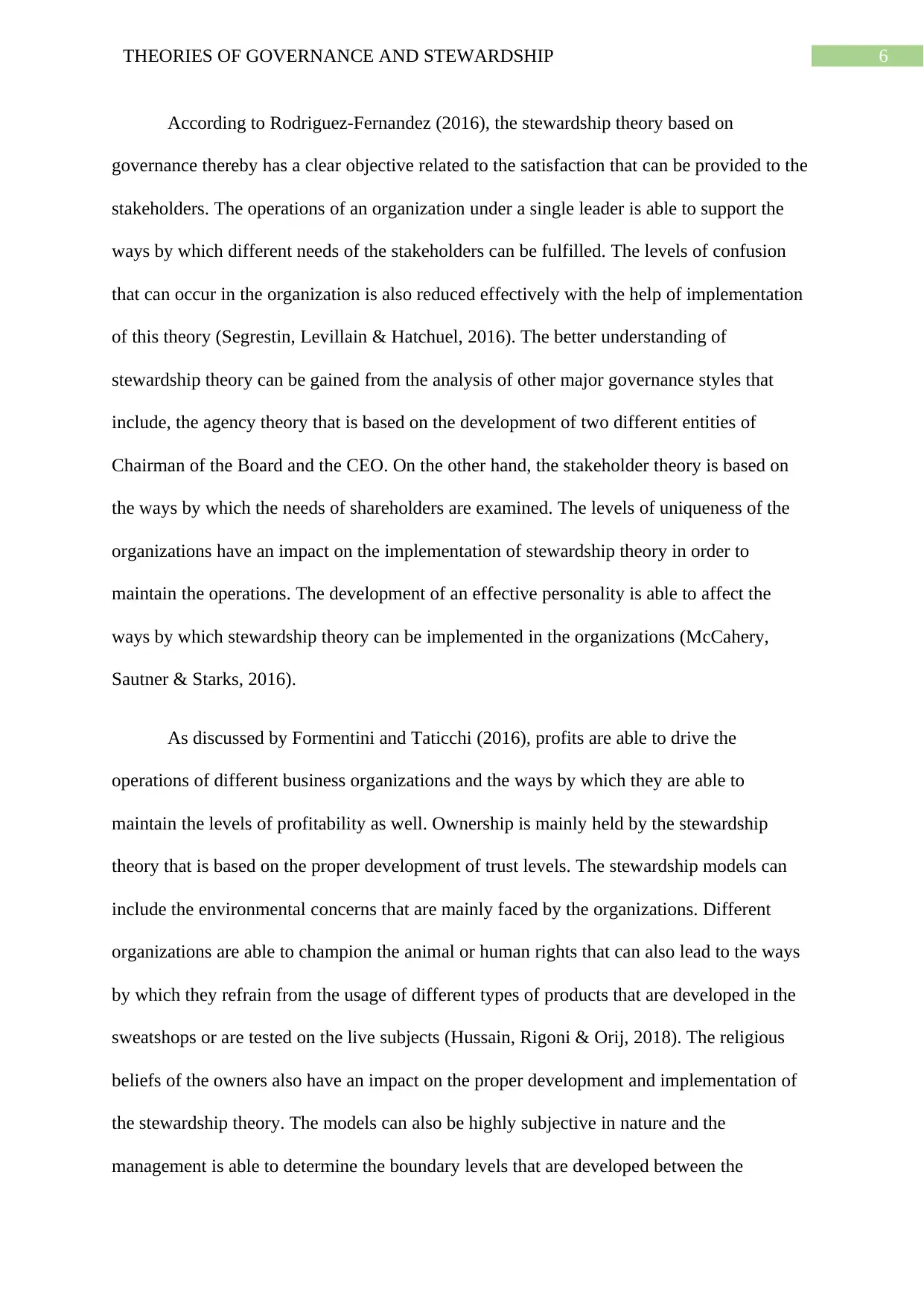
6THEORIES OF GOVERNANCE AND STEWARDSHIP
According to Rodriguez-Fernandez (2016), the stewardship theory based on
governance thereby has a clear objective related to the satisfaction that can be provided to the
stakeholders. The operations of an organization under a single leader is able to support the
ways by which different needs of the stakeholders can be fulfilled. The levels of confusion
that can occur in the organization is also reduced effectively with the help of implementation
of this theory (Segrestin, Levillain & Hatchuel, 2016). The better understanding of
stewardship theory can be gained from the analysis of other major governance styles that
include, the agency theory that is based on the development of two different entities of
Chairman of the Board and the CEO. On the other hand, the stakeholder theory is based on
the ways by which the needs of shareholders are examined. The levels of uniqueness of the
organizations have an impact on the implementation of stewardship theory in order to
maintain the operations. The development of an effective personality is able to affect the
ways by which stewardship theory can be implemented in the organizations (McCahery,
Sautner & Starks, 2016).
As discussed by Formentini and Taticchi (2016), profits are able to drive the
operations of different business organizations and the ways by which they are able to
maintain the levels of profitability as well. Ownership is mainly held by the stewardship
theory that is based on the proper development of trust levels. The stewardship models can
include the environmental concerns that are mainly faced by the organizations. Different
organizations are able to champion the animal or human rights that can also lead to the ways
by which they refrain from the usage of different types of products that are developed in the
sweatshops or are tested on the live subjects (Hussain, Rigoni & Orij, 2018). The religious
beliefs of the owners also have an impact on the proper development and implementation of
the stewardship theory. The models can also be highly subjective in nature and the
management is able to determine the boundary levels that are developed between the
According to Rodriguez-Fernandez (2016), the stewardship theory based on
governance thereby has a clear objective related to the satisfaction that can be provided to the
stakeholders. The operations of an organization under a single leader is able to support the
ways by which different needs of the stakeholders can be fulfilled. The levels of confusion
that can occur in the organization is also reduced effectively with the help of implementation
of this theory (Segrestin, Levillain & Hatchuel, 2016). The better understanding of
stewardship theory can be gained from the analysis of other major governance styles that
include, the agency theory that is based on the development of two different entities of
Chairman of the Board and the CEO. On the other hand, the stakeholder theory is based on
the ways by which the needs of shareholders are examined. The levels of uniqueness of the
organizations have an impact on the implementation of stewardship theory in order to
maintain the operations. The development of an effective personality is able to affect the
ways by which stewardship theory can be implemented in the organizations (McCahery,
Sautner & Starks, 2016).
As discussed by Formentini and Taticchi (2016), profits are able to drive the
operations of different business organizations and the ways by which they are able to
maintain the levels of profitability as well. Ownership is mainly held by the stewardship
theory that is based on the proper development of trust levels. The stewardship models can
include the environmental concerns that are mainly faced by the organizations. Different
organizations are able to champion the animal or human rights that can also lead to the ways
by which they refrain from the usage of different types of products that are developed in the
sweatshops or are tested on the live subjects (Hussain, Rigoni & Orij, 2018). The religious
beliefs of the owners also have an impact on the proper development and implementation of
the stewardship theory. The models can also be highly subjective in nature and the
management is able to determine the boundary levels that are developed between the
Paraphrase This Document
Need a fresh take? Get an instant paraphrase of this document with our AI Paraphraser
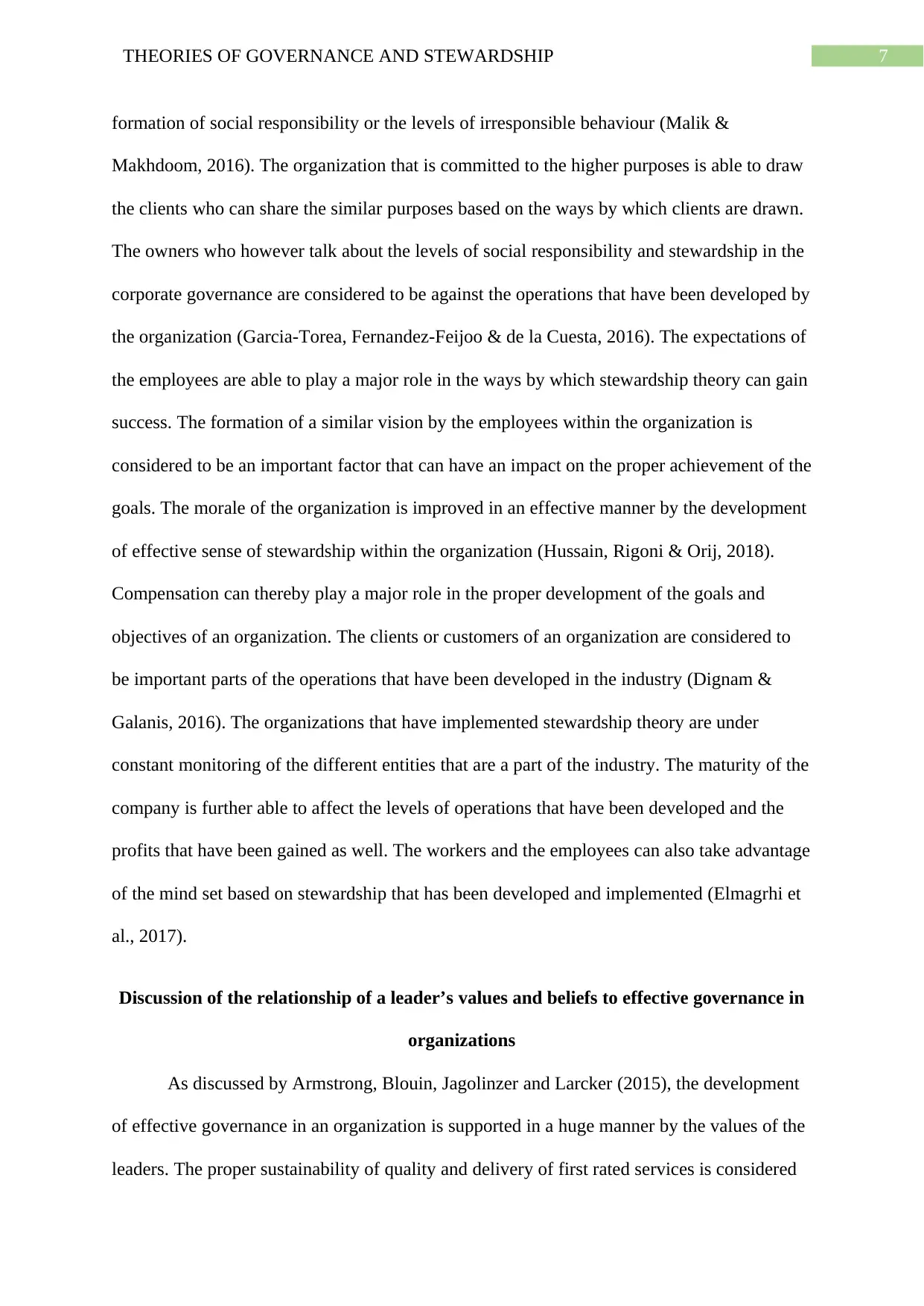
7THEORIES OF GOVERNANCE AND STEWARDSHIP
formation of social responsibility or the levels of irresponsible behaviour (Malik &
Makhdoom, 2016). The organization that is committed to the higher purposes is able to draw
the clients who can share the similar purposes based on the ways by which clients are drawn.
The owners who however talk about the levels of social responsibility and stewardship in the
corporate governance are considered to be against the operations that have been developed by
the organization (Garcia-Torea, Fernandez-Feijoo & de la Cuesta, 2016). The expectations of
the employees are able to play a major role in the ways by which stewardship theory can gain
success. The formation of a similar vision by the employees within the organization is
considered to be an important factor that can have an impact on the proper achievement of the
goals. The morale of the organization is improved in an effective manner by the development
of effective sense of stewardship within the organization (Hussain, Rigoni & Orij, 2018).
Compensation can thereby play a major role in the proper development of the goals and
objectives of an organization. The clients or customers of an organization are considered to
be important parts of the operations that have been developed in the industry (Dignam &
Galanis, 2016). The organizations that have implemented stewardship theory are under
constant monitoring of the different entities that are a part of the industry. The maturity of the
company is further able to affect the levels of operations that have been developed and the
profits that have been gained as well. The workers and the employees can also take advantage
of the mind set based on stewardship that has been developed and implemented (Elmagrhi et
al., 2017).
Discussion of the relationship of a leader’s values and beliefs to effective governance in
organizations
As discussed by Armstrong, Blouin, Jagolinzer and Larcker (2015), the development
of effective governance in an organization is supported in a huge manner by the values of the
leaders. The proper sustainability of quality and delivery of first rated services is considered
formation of social responsibility or the levels of irresponsible behaviour (Malik &
Makhdoom, 2016). The organization that is committed to the higher purposes is able to draw
the clients who can share the similar purposes based on the ways by which clients are drawn.
The owners who however talk about the levels of social responsibility and stewardship in the
corporate governance are considered to be against the operations that have been developed by
the organization (Garcia-Torea, Fernandez-Feijoo & de la Cuesta, 2016). The expectations of
the employees are able to play a major role in the ways by which stewardship theory can gain
success. The formation of a similar vision by the employees within the organization is
considered to be an important factor that can have an impact on the proper achievement of the
goals. The morale of the organization is improved in an effective manner by the development
of effective sense of stewardship within the organization (Hussain, Rigoni & Orij, 2018).
Compensation can thereby play a major role in the proper development of the goals and
objectives of an organization. The clients or customers of an organization are considered to
be important parts of the operations that have been developed in the industry (Dignam &
Galanis, 2016). The organizations that have implemented stewardship theory are under
constant monitoring of the different entities that are a part of the industry. The maturity of the
company is further able to affect the levels of operations that have been developed and the
profits that have been gained as well. The workers and the employees can also take advantage
of the mind set based on stewardship that has been developed and implemented (Elmagrhi et
al., 2017).
Discussion of the relationship of a leader’s values and beliefs to effective governance in
organizations
As discussed by Armstrong, Blouin, Jagolinzer and Larcker (2015), the development
of effective governance in an organization is supported in a huge manner by the values of the
leaders. The proper sustainability of quality and delivery of first rated services is considered
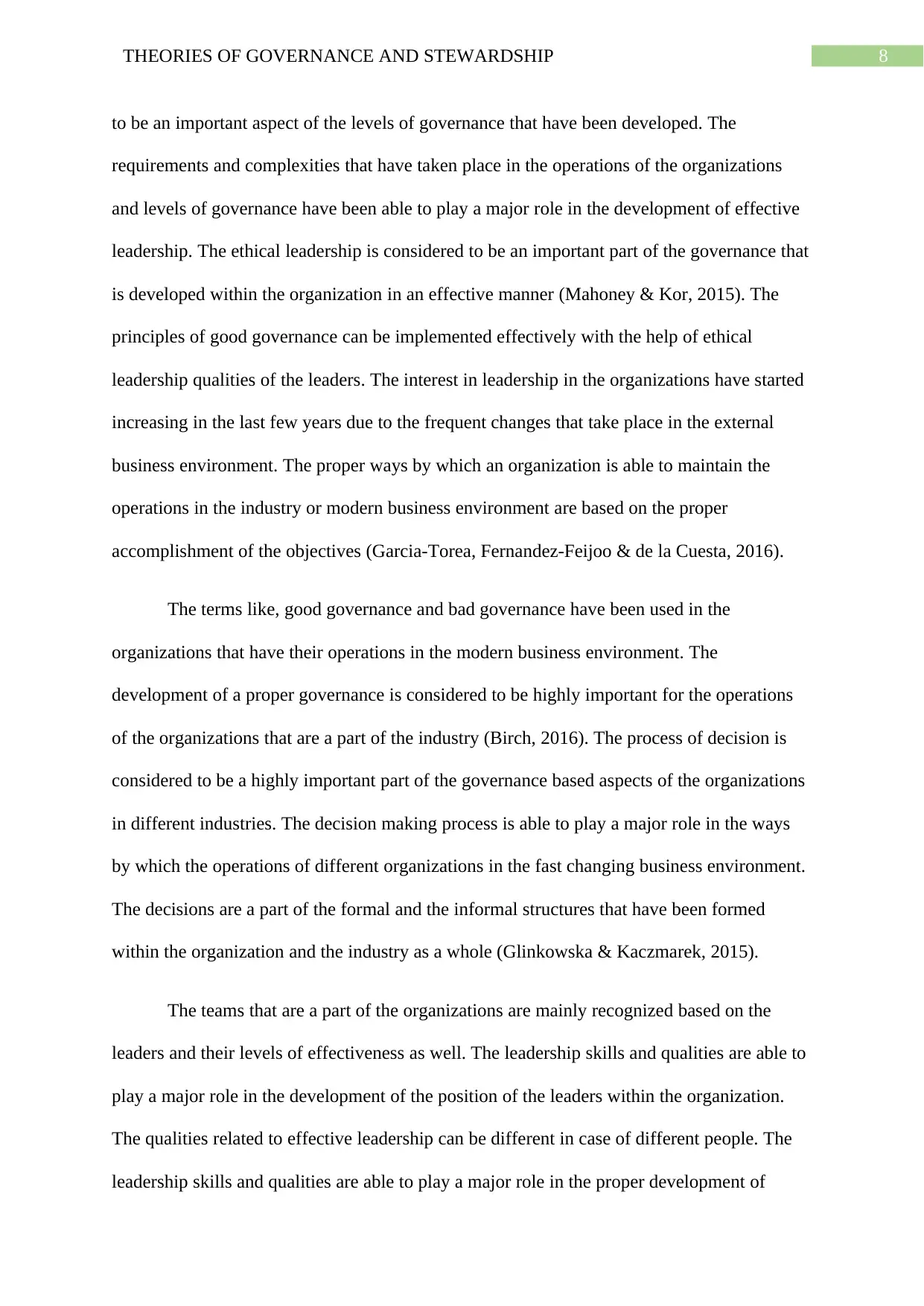
8THEORIES OF GOVERNANCE AND STEWARDSHIP
to be an important aspect of the levels of governance that have been developed. The
requirements and complexities that have taken place in the operations of the organizations
and levels of governance have been able to play a major role in the development of effective
leadership. The ethical leadership is considered to be an important part of the governance that
is developed within the organization in an effective manner (Mahoney & Kor, 2015). The
principles of good governance can be implemented effectively with the help of ethical
leadership qualities of the leaders. The interest in leadership in the organizations have started
increasing in the last few years due to the frequent changes that take place in the external
business environment. The proper ways by which an organization is able to maintain the
operations in the industry or modern business environment are based on the proper
accomplishment of the objectives (Garcia-Torea, Fernandez-Feijoo & de la Cuesta, 2016).
The terms like, good governance and bad governance have been used in the
organizations that have their operations in the modern business environment. The
development of a proper governance is considered to be highly important for the operations
of the organizations that are a part of the industry (Birch, 2016). The process of decision is
considered to be a highly important part of the governance based aspects of the organizations
in different industries. The decision making process is able to play a major role in the ways
by which the operations of different organizations in the fast changing business environment.
The decisions are a part of the formal and the informal structures that have been formed
within the organization and the industry as a whole (Glinkowska & Kaczmarek, 2015).
The teams that are a part of the organizations are mainly recognized based on the
leaders and their levels of effectiveness as well. The leadership skills and qualities are able to
play a major role in the development of the position of the leaders within the organization.
The qualities related to effective leadership can be different in case of different people. The
leadership skills and qualities are able to play a major role in the proper development of
to be an important aspect of the levels of governance that have been developed. The
requirements and complexities that have taken place in the operations of the organizations
and levels of governance have been able to play a major role in the development of effective
leadership. The ethical leadership is considered to be an important part of the governance that
is developed within the organization in an effective manner (Mahoney & Kor, 2015). The
principles of good governance can be implemented effectively with the help of ethical
leadership qualities of the leaders. The interest in leadership in the organizations have started
increasing in the last few years due to the frequent changes that take place in the external
business environment. The proper ways by which an organization is able to maintain the
operations in the industry or modern business environment are based on the proper
accomplishment of the objectives (Garcia-Torea, Fernandez-Feijoo & de la Cuesta, 2016).
The terms like, good governance and bad governance have been used in the
organizations that have their operations in the modern business environment. The
development of a proper governance is considered to be highly important for the operations
of the organizations that are a part of the industry (Birch, 2016). The process of decision is
considered to be a highly important part of the governance based aspects of the organizations
in different industries. The decision making process is able to play a major role in the ways
by which the operations of different organizations in the fast changing business environment.
The decisions are a part of the formal and the informal structures that have been formed
within the organization and the industry as a whole (Glinkowska & Kaczmarek, 2015).
The teams that are a part of the organizations are mainly recognized based on the
leaders and their levels of effectiveness as well. The leadership skills and qualities are able to
play a major role in the development of the position of the leaders within the organization.
The qualities related to effective leadership can be different in case of different people. The
leadership skills and qualities are able to play a major role in the proper development of
⊘ This is a preview!⊘
Do you want full access?
Subscribe today to unlock all pages.

Trusted by 1+ million students worldwide
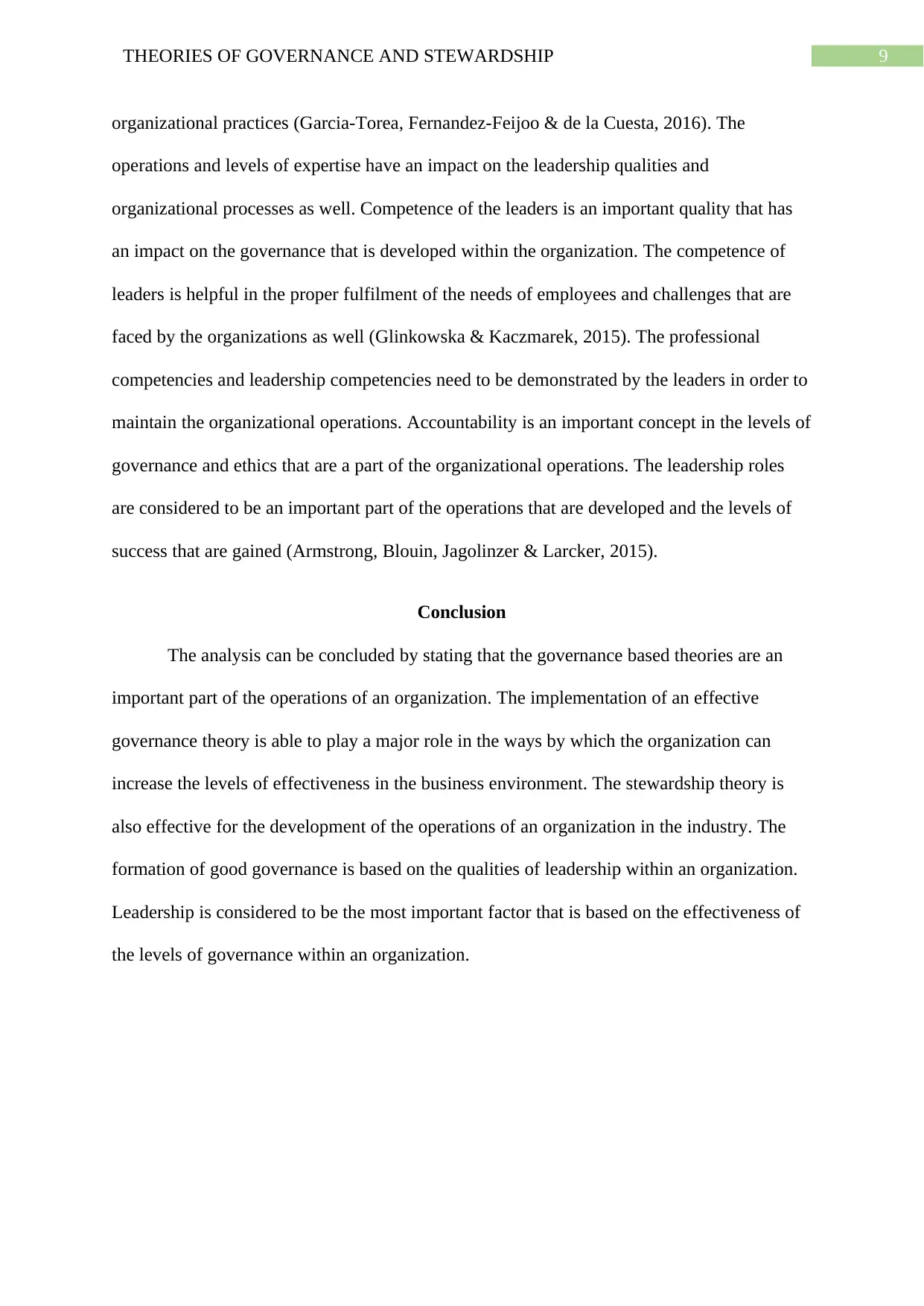
9THEORIES OF GOVERNANCE AND STEWARDSHIP
organizational practices (Garcia-Torea, Fernandez-Feijoo & de la Cuesta, 2016). The
operations and levels of expertise have an impact on the leadership qualities and
organizational processes as well. Competence of the leaders is an important quality that has
an impact on the governance that is developed within the organization. The competence of
leaders is helpful in the proper fulfilment of the needs of employees and challenges that are
faced by the organizations as well (Glinkowska & Kaczmarek, 2015). The professional
competencies and leadership competencies need to be demonstrated by the leaders in order to
maintain the organizational operations. Accountability is an important concept in the levels of
governance and ethics that are a part of the organizational operations. The leadership roles
are considered to be an important part of the operations that are developed and the levels of
success that are gained (Armstrong, Blouin, Jagolinzer & Larcker, 2015).
Conclusion
The analysis can be concluded by stating that the governance based theories are an
important part of the operations of an organization. The implementation of an effective
governance theory is able to play a major role in the ways by which the organization can
increase the levels of effectiveness in the business environment. The stewardship theory is
also effective for the development of the operations of an organization in the industry. The
formation of good governance is based on the qualities of leadership within an organization.
Leadership is considered to be the most important factor that is based on the effectiveness of
the levels of governance within an organization.
organizational practices (Garcia-Torea, Fernandez-Feijoo & de la Cuesta, 2016). The
operations and levels of expertise have an impact on the leadership qualities and
organizational processes as well. Competence of the leaders is an important quality that has
an impact on the governance that is developed within the organization. The competence of
leaders is helpful in the proper fulfilment of the needs of employees and challenges that are
faced by the organizations as well (Glinkowska & Kaczmarek, 2015). The professional
competencies and leadership competencies need to be demonstrated by the leaders in order to
maintain the organizational operations. Accountability is an important concept in the levels of
governance and ethics that are a part of the organizational operations. The leadership roles
are considered to be an important part of the operations that are developed and the levels of
success that are gained (Armstrong, Blouin, Jagolinzer & Larcker, 2015).
Conclusion
The analysis can be concluded by stating that the governance based theories are an
important part of the operations of an organization. The implementation of an effective
governance theory is able to play a major role in the ways by which the organization can
increase the levels of effectiveness in the business environment. The stewardship theory is
also effective for the development of the operations of an organization in the industry. The
formation of good governance is based on the qualities of leadership within an organization.
Leadership is considered to be the most important factor that is based on the effectiveness of
the levels of governance within an organization.
Paraphrase This Document
Need a fresh take? Get an instant paraphrase of this document with our AI Paraphraser
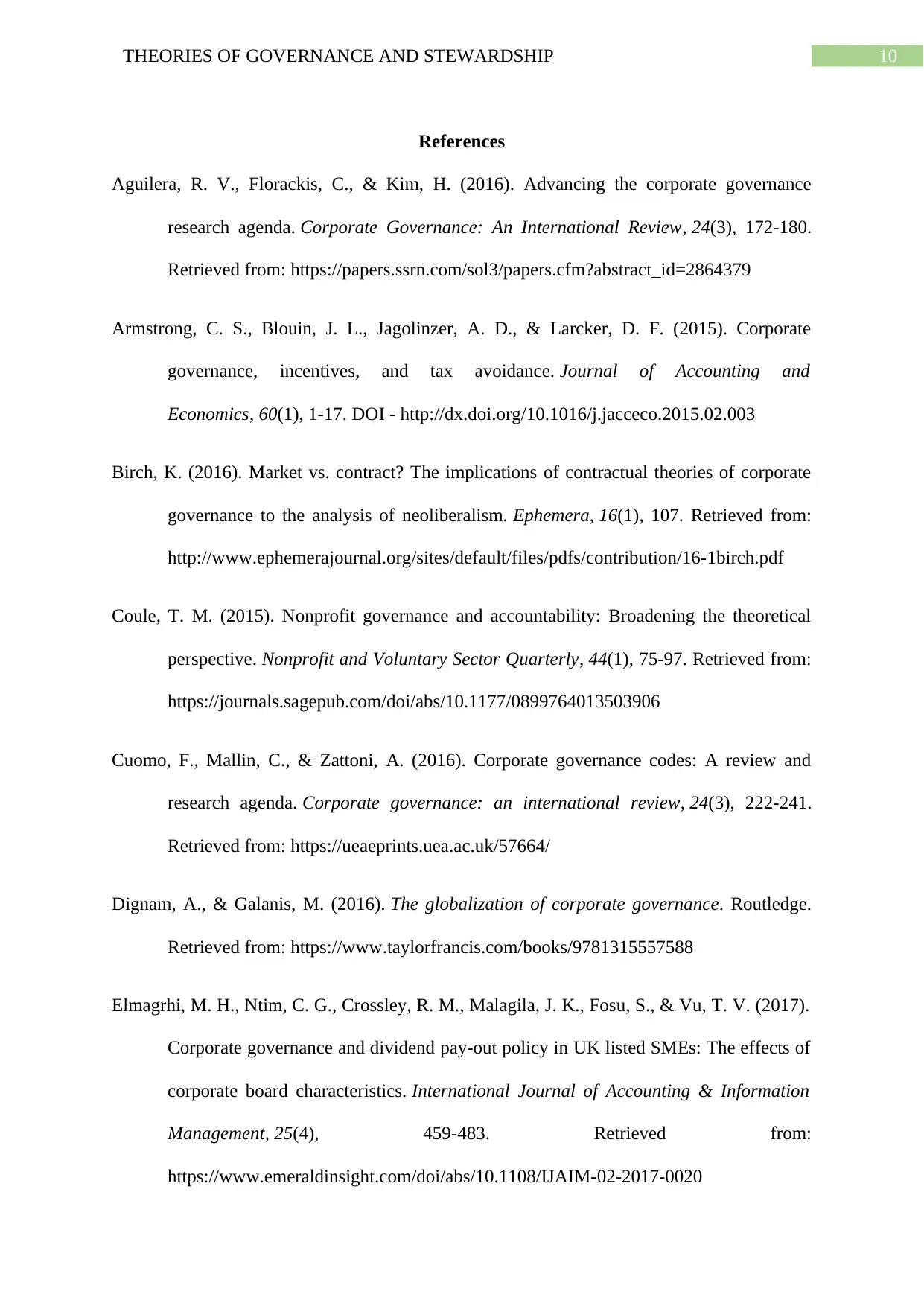
10THEORIES OF GOVERNANCE AND STEWARDSHIP
References
Aguilera, R. V., Florackis, C., & Kim, H. (2016). Advancing the corporate governance
research agenda. Corporate Governance: An International Review, 24(3), 172-180.
Retrieved from: https://papers.ssrn.com/sol3/papers.cfm?abstract_id=2864379
Armstrong, C. S., Blouin, J. L., Jagolinzer, A. D., & Larcker, D. F. (2015). Corporate
governance, incentives, and tax avoidance. Journal of Accounting and
Economics, 60(1), 1-17. DOI - http://dx.doi.org/10.1016/j.jacceco.2015.02.003
Birch, K. (2016). Market vs. contract? The implications of contractual theories of corporate
governance to the analysis of neoliberalism. Ephemera, 16(1), 107. Retrieved from:
http://www.ephemerajournal.org/sites/default/files/pdfs/contribution/16-1birch.pdf
Coule, T. M. (2015). Nonprofit governance and accountability: Broadening the theoretical
perspective. Nonprofit and Voluntary Sector Quarterly, 44(1), 75-97. Retrieved from:
https://journals.sagepub.com/doi/abs/10.1177/0899764013503906
Cuomo, F., Mallin, C., & Zattoni, A. (2016). Corporate governance codes: A review and
research agenda. Corporate governance: an international review, 24(3), 222-241.
Retrieved from: https://ueaeprints.uea.ac.uk/57664/
Dignam, A., & Galanis, M. (2016). The globalization of corporate governance. Routledge.
Retrieved from: https://www.taylorfrancis.com/books/9781315557588
Elmagrhi, M. H., Ntim, C. G., Crossley, R. M., Malagila, J. K., Fosu, S., & Vu, T. V. (2017).
Corporate governance and dividend pay-out policy in UK listed SMEs: The effects of
corporate board characteristics. International Journal of Accounting & Information
Management, 25(4), 459-483. Retrieved from:
https://www.emeraldinsight.com/doi/abs/10.1108/IJAIM-02-2017-0020
References
Aguilera, R. V., Florackis, C., & Kim, H. (2016). Advancing the corporate governance
research agenda. Corporate Governance: An International Review, 24(3), 172-180.
Retrieved from: https://papers.ssrn.com/sol3/papers.cfm?abstract_id=2864379
Armstrong, C. S., Blouin, J. L., Jagolinzer, A. D., & Larcker, D. F. (2015). Corporate
governance, incentives, and tax avoidance. Journal of Accounting and
Economics, 60(1), 1-17. DOI - http://dx.doi.org/10.1016/j.jacceco.2015.02.003
Birch, K. (2016). Market vs. contract? The implications of contractual theories of corporate
governance to the analysis of neoliberalism. Ephemera, 16(1), 107. Retrieved from:
http://www.ephemerajournal.org/sites/default/files/pdfs/contribution/16-1birch.pdf
Coule, T. M. (2015). Nonprofit governance and accountability: Broadening the theoretical
perspective. Nonprofit and Voluntary Sector Quarterly, 44(1), 75-97. Retrieved from:
https://journals.sagepub.com/doi/abs/10.1177/0899764013503906
Cuomo, F., Mallin, C., & Zattoni, A. (2016). Corporate governance codes: A review and
research agenda. Corporate governance: an international review, 24(3), 222-241.
Retrieved from: https://ueaeprints.uea.ac.uk/57664/
Dignam, A., & Galanis, M. (2016). The globalization of corporate governance. Routledge.
Retrieved from: https://www.taylorfrancis.com/books/9781315557588
Elmagrhi, M. H., Ntim, C. G., Crossley, R. M., Malagila, J. K., Fosu, S., & Vu, T. V. (2017).
Corporate governance and dividend pay-out policy in UK listed SMEs: The effects of
corporate board characteristics. International Journal of Accounting & Information
Management, 25(4), 459-483. Retrieved from:
https://www.emeraldinsight.com/doi/abs/10.1108/IJAIM-02-2017-0020

11THEORIES OF GOVERNANCE AND STEWARDSHIP
Formentini, M., & Taticchi, P. (2016). Corporate sustainability approaches and governance
mechanisms in sustainable supply chain management. Journal of Cleaner
Production, 112, 1920-1933. Retrieved from:
https://www.sciencedirect.com/science/article/pii/S0959652614013699
Garcia-Torea, N., Fernandez-Feijoo, B., & de la Cuesta, M. (2016). Board of director's
effectiveness and the stakeholder perspective of corporate governance: Do effective
boards promote the interests of shareholders and stakeholders?. BRQ Business
Research Quarterly, 19(4), 246-260. Retrieved from:
https://www.sciencedirect.com/science/article/pii/S2340943616300317
Glinkowska, B., & Kaczmarek, B. (2015). Classical and modern concepts of corporate
governance (Stewardship Theory and Agency Theory). Management, 19(2), 84-92.
DOI: 10.1515/manment-2015-0015
Griffith, S. J. (2015). Corporate governance in an era of compliance. Wm. & Mary L.
Rev., 57, 2075. Retrieved from: https://scholarship.law.wm.edu/cgi/viewcontent.cgi?
article=3657&context=wmlr
Hussain, N., Rigoni, U., & Orij, R. P. (2018). Corporate governance and sustainability
performance: Analysis of triple bottom line performance. Journal of Business
Ethics, 149(2), 411-432. Retrieved from:
https://link.springer.com/article/10.1007/s10551-016-3099-5
Levermore, R., & Moore, N. (2015). The need to apply new theories to “Sport
CSR”. Corporate Governance, 15(2), 249-253. Retrieved from:
https://www.emeraldinsight.com/doi/abs/10.1108/CG-09-2014-0113
Formentini, M., & Taticchi, P. (2016). Corporate sustainability approaches and governance
mechanisms in sustainable supply chain management. Journal of Cleaner
Production, 112, 1920-1933. Retrieved from:
https://www.sciencedirect.com/science/article/pii/S0959652614013699
Garcia-Torea, N., Fernandez-Feijoo, B., & de la Cuesta, M. (2016). Board of director's
effectiveness and the stakeholder perspective of corporate governance: Do effective
boards promote the interests of shareholders and stakeholders?. BRQ Business
Research Quarterly, 19(4), 246-260. Retrieved from:
https://www.sciencedirect.com/science/article/pii/S2340943616300317
Glinkowska, B., & Kaczmarek, B. (2015). Classical and modern concepts of corporate
governance (Stewardship Theory and Agency Theory). Management, 19(2), 84-92.
DOI: 10.1515/manment-2015-0015
Griffith, S. J. (2015). Corporate governance in an era of compliance. Wm. & Mary L.
Rev., 57, 2075. Retrieved from: https://scholarship.law.wm.edu/cgi/viewcontent.cgi?
article=3657&context=wmlr
Hussain, N., Rigoni, U., & Orij, R. P. (2018). Corporate governance and sustainability
performance: Analysis of triple bottom line performance. Journal of Business
Ethics, 149(2), 411-432. Retrieved from:
https://link.springer.com/article/10.1007/s10551-016-3099-5
Levermore, R., & Moore, N. (2015). The need to apply new theories to “Sport
CSR”. Corporate Governance, 15(2), 249-253. Retrieved from:
https://www.emeraldinsight.com/doi/abs/10.1108/CG-09-2014-0113
⊘ This is a preview!⊘
Do you want full access?
Subscribe today to unlock all pages.

Trusted by 1+ million students worldwide
1 out of 14
Related Documents
Your All-in-One AI-Powered Toolkit for Academic Success.
+13062052269
info@desklib.com
Available 24*7 on WhatsApp / Email
![[object Object]](/_next/static/media/star-bottom.7253800d.svg)
Unlock your academic potential
Copyright © 2020–2025 A2Z Services. All Rights Reserved. Developed and managed by ZUCOL.





